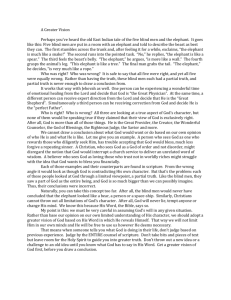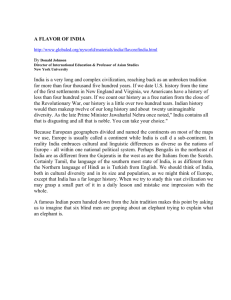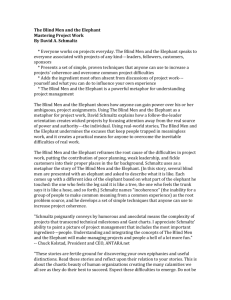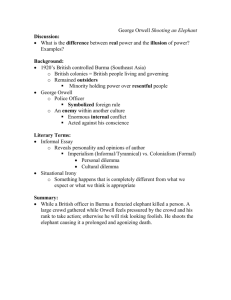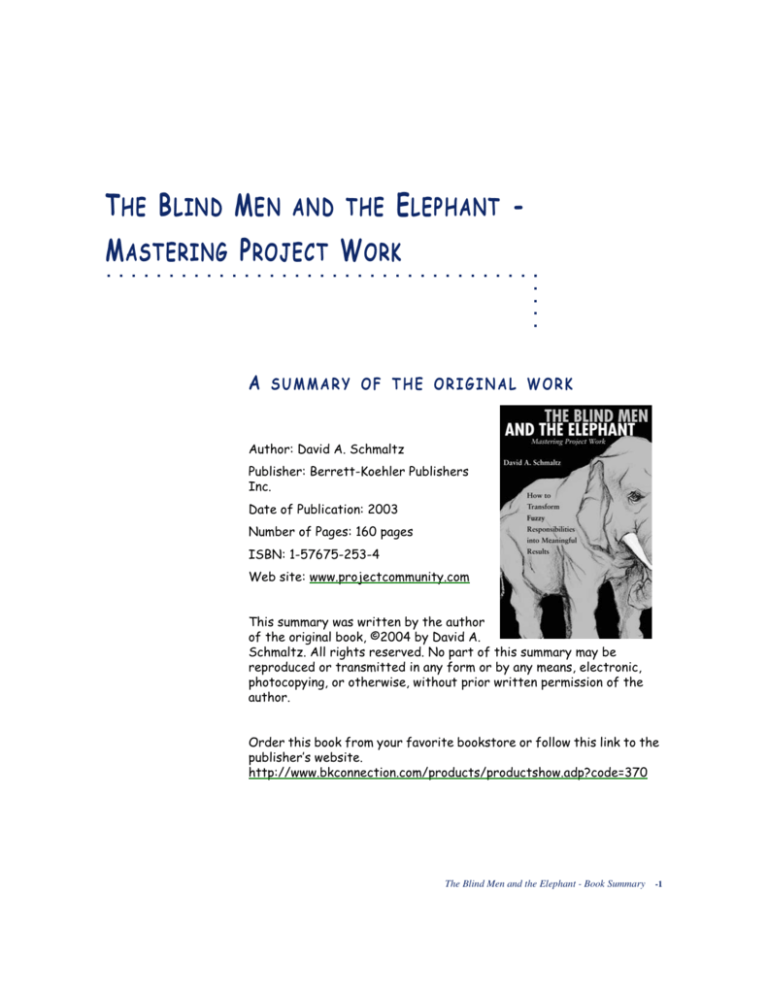
T HE B LIND M EN AND THE E LEPHANT M ASTERING P ROJECT W ORK
.....
...................................
A
SUMMARY OF THE ORIGINAL WORK
Author: David A. Schmaltz
Publisher: Berrett-Koehler Publishers
Inc.
Date of Publication: 2003
Number of Pages: 160 pages
ISBN: 1-57675-253-4
Web site: www.projectcommunity.com
This summary was written by the author
of the original book, ©2004 by David A.
Schmaltz. All rights reserved. No part of this summary may be
reproduced or transmitted in any form or by any means, electronic,
photocopying, or otherwise, without prior written permission of the
author.
Order this book from your favorite bookstore or follow this link to the
publisher’s website.
http://www.bkconnection.com/products/productshow.adp?code=370
The Blind Men and the Elephant - Book Summary -1
About the Author
.....
T H E B L I N D M E N A N D T H E E L E P H A N T - M A S T E R I N G P R O J E C T WO R K
.A. .B. .O. . .U. .T. . . .T. .H. . .E. . . A. . .U. .T. . H. . .O. . R. . . . . . . . . . . . . . . . . . . . . .
“ creating new
frames of
reference for
approaching
projects ”
David A. Schmaltz is an author, teacher, principled consultant, and
founder of True North project guidance strategies, Inc., a strategic
consultancy focused on helping people work really well together. His
latest book, The Blind Men and the Elephant: Mastering Project
Work—How to Transform Fuzzy Responsibilities into Meaningful
Results (Berrett-Koehler Publishers), joins David’s earlier work, This
Isn’t a Cookbook: The Elements of Project Style, and True North’s
newsletter, Compass, in sharing his unique insights into adaptive
project work.
Prior to founding True North, David was president and principal
consultant of Silicon Valley’s Ontara Corporation. In 1996, David
purchased Ontara’s intellectual property, incorporating it into True
North’s Mastering Projects Workshop to extend the usefulness of
Ontara’s initial research into what makes high technology projects
work.
David created True North’s uniquely powerful Brief Consulting model,
authored True North’s Mastering Projects Workshop, and acts as
editor of and principal contributor to Compass. David also served as
faculty for Jerry and Dani Weinberg’s Problem Solving Leadership
Workshop.
David uses his role as writer and consultant to help people learn what
they need to know to make their assignments work well. His expertise
includes creating new frames of reference for approaching projects
and helping clients discover how their own practical models apply to
their real-world situations.
The Blind Men and the Elephant - Book Summary -2
T H E B L I N D M E N A N D T H E E L E P H A N T - M A S T E R I N G P R O J E C T WO R K
The Big Idea
THE BIG IDEA
........................................................
“ even the most
difficult effort
can become a
juicy experience,
... so everyone
wants to do
another one like
that again.”
Even the most difficult projects can become
juicy personal experiences. Successful
project completion takes more than
logistical coordination—it requires uniting a
wide variety of perspectives. Though
everyone involved remains unavoidably
“blind” to each other’s point of view, this
blindness need not inhibit successful
completion nor create wicked experiences.
The objective is not to overcome this
inevitable blindness but to properly leverage it. Properly leveraged,
even the most difficult effort can become a juicy experience, so that
when it’s over, everyone wants to do another one like that again.
This book shows how to bridge the gaps between inevitably blind
perspectives. It explains how to achieve coherence, which enables even
the most encumbered to meaningfully work together. The entertaining
stories come from the author’s personal project work experiences and
from instructive metaphors.
INTRODUCTION
........................................................
Over the last decade, a revolution occurred in project work. What
used to be definable by simple, step-wise plans has become increasingly
uncertain—fuzzier and fuzzier. Despite this revolution, project
traditions persist. Companies expect managers to control these
projects as if they were controlling the more concrete projects from
the past. Projects are surrounded by the evidence of misguided
expectations:
• Management lays fixed track, expecting everyone to get on it and
stay on it—or to get back on it, should they stray.
-3
The Blind Men and the Elephant - Book Summary
Introduction
.....
T H E B L I N D M E N A N D T H E E L E P H A N T - M A S T E R I N G P R O J E C T WO R K
• Funding authorities cling to traditional success criteria, expecting
“on-time, on-budget, on-spec” performances, regardless of the
shifting context.
• Auditors continue to expect detailed plans early in projects, even
though both auditors and project managers know that they will be
shocked by the magnitude of the changes over time.
• Managers still gauge progress by inches, expecting their team
members to explain every deviation.
Every individual
has the power to
transform their
experience from
meaningless
obligation to
juicy
opportunity.
Clinging to these traditions transforms challenging, fuzzy projects into
impossibly “wicked” ones. Every individual involved in these efforts has
the power, often unrecognized, to transform his or her own experience
from wicked to fuzzy; from meaningless obligation to juicy opportunity.
The book considers a more appropriate frame of reference for
engaging in this fuzzy work, proposing that these efforts are more
meaningfully approached as extended conversations than as simple
exercises in command and control. The author anchors this proposition
in John Godfrey Saxe’s 19th-century poem, The Blind Men and the
Elephant.
In this fable, six blind men decide to “see” an elephant:
• The first finds the elephant’s side, interpreting
the animal as being a wall blocking the way to
anything meaningful.
• The second happens upon a tusk, deciding that
the animal is a spear that any good soldier might
feel obligated to carry into battle.
• The third touches the trunk, concluding that
the elephant is a snake that no one should trust.
• The fourth feels a leg, describing the elephant
as a tree trunk supporting everyone’s efforts.
• The fifth chances upon an ear, experiencing the animal as a fan that
might coax an ember into a flame.
• The sixth grabs the tail, declaring that the beast is very much like a
rope that can tie together a coherent whole.
Because the blind men cannot agree on what the elephant really is,
rather than seeing the elephant, they engage in an endless argument—
with the ferocity and certainty of any theologic war—where each
individual is right and all are in the wrong. The author uses these
The Blind Men and the Elephant - Book Summary -4
T H E B L I N D M E N A N D T H E E L E P H A N T - M A S T E R I N G P R O J E C T WO R K
Introduction
metaphors to show how to transform project fuzziness into the means
for creating coherent and collectively meaningful results.
THE NEED
FOR
COHERENCE
Each project contributor will, like the fabled blind men, carry a unique
notion of the overall work effort; each perspective will be different
from what others hold. These differences between individual
perception and collective reality make project work fuzzy. Coherence
can resolve these difficulties. Coherence is that state where we see
the world through each other’s eyes—where we quite magically catch
ourselves seeing the world as others see it.
Coherence:
that state where
we quite
magically catch
ourselves seeing
the world as
others see it
The story of the six blind men and the elephant illustrates a lack of
coherence. Each blind man experiences a portion of the whole animal,
perceiving his part as representing a whole, when it does not. Insisting
that he sees the elephant, each experiences only his piece of the
overall effort, and no one else’s.
The delusion that one perspective is or should be the same as any
other’s encourages incoherence. Incoherence sparks theologic wars,
not meaningful results. So emerges the need for a leader who can
induce coherence when multiple perspectives tangle.
Every project replays the story of these blind men around an elephant.
From within each individual’s personal experience, it seems only
reasonable to conclude that everyone else arrayed around the beast
experiences this animal as he does. But the individual’s personal
experience most certainly does not reasonably mirror everyone else’s.
It’s not supposed to.
When each blind man can integrate every other blind man’s curious
testimony with his own perspective, a collective coherence emerges
along with the elephant. This coherence creates remarkable
possibilities, as if the blind men could actually see through each other’s
eyes. Coherence-building leadership requires integrating disparate
perspectives, not enforcing a single, dominant one.
The author explores the blind men’s experiences through metaphors—
the wall, the spear, the snake, the tree, the fan, and the rope—to more
properly explain effective leader and follower roles.
-5
The Blind Men and the Elephant - Book Summary
The Wall: Discovering Purpose
.....
T H E B L I N D M E N A N D T H E E L E P H A N T - M A S T E R I N G P R O J E C T WO R K
THE WALL: DISCOVERING
PURPOSE
........................................................
The wall signifies a barrier between achieving the
project’s objective and using the effort to pursue a
personally compelling purpose. At the beginning,
uncovering the project’s objective seems to
overshadow any need to discover personal purpose.
When the going gets tougher, though, many are
tempted to simply sacrifice themselves for the
effort, as if they could improve the result by
choosing to forgo any personal reward.
The most often overlooked critical success factor
is the answer to a deeply personal question, “What
do I want?”
The most often
overlooked
critical success
factor is the
answer to a
deeply personal
question, “What
do I want?”
• Every assignment offers opportunity as well as
obligation. We easily focus so intently upon the
obligation that we miss any opportunity to use our assignment as a
medium for pursuing what we truly want for ourselves. A compelling
personal purpose makes any work more meaningful.
• Projects succeed and projects fail—either way, projects eventually
end. Project work brings the certainty that you are working yourself
out of a job. This easily translates into working yourself out of a life
unless you know how to use your project assignment to create your
life.
• Walls appear when people lose touch with what they want from their
project experience. The effort to clarify, quantify, and satisfy the
project’s objectives fades into meaninglessness when individuals fail
to connect their effort to something they want. Rather than
engaging by asking only, “What do you want me to do?” consider
extending your inquiry to ask, “What do I want?”
You have to know what you want in order to overcome the wall. When
powered by the pursuit of a personally juicy purpose, who could be
depleted by any effort? Understand the project’s objective but don’t
neglect to find your own project within your project assignment. Know
what you want.
The Blind Men and the Elephant - Book Summary -6
T H E B L I N D M E N A N D T H E E L E P H A N T - M A S T E R I N G P R O J E C T WO R K
The Spear: Bringing Your Own Good Judgment into Play
THE SPEAR: BRINGING YOUR
OWN GOOD JUDGMENT INTO
PLAY
........................................................
The elephant’s tusk might seem like a spear, a
defensive weapon. However, it might as easily
serve as a walking stick. Does your project really
need a defensive weapon more than it needs a
walking stick? What does your own good judgment
tell you?
“We must
assert our own
good judgment
in our work or
suffer under
the judgment of
fools.”
In military service, orders are supposed to be
carried out as commanded. Obedience and
discipline are the highest priority. Individual
judgment shrinks beneath the expectation of
blind obedience. Is your project really a war?
Does it require a battlefield’s good-soldier
compliance? Perhaps you could put to better use
what first seemed necessarily like a spear.
Fuzzy projects need “bad” soldiers, people who will
• Insist upon choices
• Leave their options open
• Question authority
• Tolerate well the potential embarrassment and inconvenience that
come with using their own good judgment
Fuzzy projects demand leaders who can
• Leave an array of implementation alternatives open to their teams
• Rely on the best judgment of those doing the work
• Accept results other than exactly what they first expected
Fuzzy project work requires a variety of approaches, where the means
can more often be decided by something other than command and
control. We must assert our own good judgment in our work or suffer
under the judgment of fools.
-7
The Blind Men and the Elephant - Book Summary
The Snake: Creating Trust
.....
T H E B L I N D M E N A N D T H E E L E P H A N T - M A S T E R I N G P R O J E C T WO R K
THE SNAKE: CREATING TRUST
........................................................
“Where trust
cannot find a
foothold,
meaningful
success seems
to slip away,
too.”
You can always trust a snake to be a snake. Give
someone the label of snake, and he’ll seem to
become determined to live up to the name you’ve
given him. Trust is an essential element within
fuzzy projects. Where trust cannot find a
foothold, meaningful success seems to slip away,
too.
Trust cannot be earned, but it can be extended.
The author explores the relationship between
the Peanuts cartoon characters Charlie Brown
and Lucy as they play with a football to
demonstrate how trusting becomes its own
reward and distrust creates a self-fulfilling, sorry sort of safety.
We create trust by extending it. We undermine the possibility of
trustworthiness by withholding trust. If someone has proved herself
to be a snake, by all means extend caution and protect yourself and
your project. But if you expect someone to prove herself worthy of
your trust, you must extend your trust first; otherwise, you’ll more
than likely find just another snake slithering into your effort.
THE TREE: DISCOVERING
ORGANIZATION
........................................................
Trees are hierarchies branching both up and down from
a central trunk. We see the trunk or the canopy and
recognize a tree without seeing the part of the
sustaining organization working silently below ground.
Project organizations are hierarchies that seem to
branch from a central point. But like trees, project
organizations are more complex than they appear.
When we see a team pursuing an objective, we
The Blind Men and the Elephant - Book Summary -8
T H E B L I N D M E N A N D T H E E L E P H A N T - M A S T E R I N G P R O J E C T WO R K
The Fan: Encouraging an Ember into Flame
recognize a project without ever detecting the invisible networks
sustaining it.
Organization means something different to those organizing than to
those being organized. Being organized suggests that some have to
follow another’s organization, to adopt another’s sense of natural
order.
“Our
impatience with
the ordering
process will
always be the
strongest
barrier to
robust order.”
What about when this imposed order doesn’t feel orderly? How can
order be achieved by anyone forgoing his natural sense of order and
adopting someone else’s orderliness?
However a leader might formally organize an effort, its informal
organization will sustain it. A community will emerge. These
communities, these informal sustaining networks of relationships,
cannot be engineered, but they can emerge with patience. Sitting with
the initial disorder can encourage a more coherent and robust
community, regardless of the formal organization chosen or imposed.
Our impatience with the ordering process will always be the strongest
barrier to robust order. Our reluctance to sit in the middle of the
mess long enough to understand and come to some agreement about its
nature before responding to it remains our greatest adversary when
planning. Our urgent need for order seems at the root of our projects’
continuing disorder.
THE FAN: ENCOURAGING AN
EMBER INTO FLAME
........................................................
No one is apathetic, except when pursuing
someone else’s goals. The leader’s efforts at
motivating don’t motivate most project
participants. Dangling carrots and threatening
sticks can‘t create coherent community, and
incoherent community has always been the true
source of poor project performance. A leader’s
proper role cannot be found in motivating his
community.
-9
The Blind Men and the Elephant - Book Summary
The Rope: Connecting with Coherence
“Every
member of
every project
community is
fully capable
of motivating
himself.”
.....
T H E B L I N D M E N A N D T H E E L E P H A N T - M A S T E R I N G P R O J E C T WO R K
Every member of every project community is fully capable of
motivating himself. If motivation is an individual responsibility, what
can the leader contribute? He can help each member find his project
within his project assignment.
Who could fail to feel motivated if she is using her project assignment
to pursue some personally juicy objective? Incoherence results
whenever people lose connection with their personal purpose for being
involved. Collective coherence naturally grows from clarifying individual
purpose.
Their motivation has to be their own responsibility. Everyone has a
spark inside and everyone can fan his own spark into flame. A leader
can help another find his fan and his spark, his project within his
project assignment, by listening and simply pointing out what might not
have been very obvious to him. A listening ear can help another
discover the ember already smoldering inside.
THE ROPE: CONNECTING WITH
COHERENCE
........................................................
How do leaders create coherent project
communities? They don’t! Coherence emerges from
community. A leader can encourage a few
preconditions that help create a sense of community
from which coherence can emerge.
Coherent communities share some, and sometimes
all, of the following preconditions:
• Blindness—They are composed of acknowledged
“blind men” rather than blind certainty. They see
that they cannot see everything. Embracing
blindness doesn’t turn out to be either a hopeless
or a helpless strategy, but one that appropriately sets the frame of
reference for an effort.
• Elephant—They share an ungraspable something, an elephant.
Complexity creates elephants. When an objective can be achieved
The Blind Men and the Elephant - Book Summary -10
T H E B L I N D M E N A N D T H E E L E P H A N T - M A S T E R I N G P R O J E C T WO R K
The Rope: Connecting with Coherence
only by bringing together many different perspectives, elephants
are usually around.
• Frustrating common experiences—They have survived a struggle
together. Coherence gets forged from messes. Communities that
have not evolved beyond their initial nice-niceness rarely experience
the coherence beyond.
• Patience—They hasten slowly, understanding that coherence might
not emerge until near the end of their effort, but it will be well
worth the wait. Pursuing coherence creates coherence, but only over
time.
Coherence,
that ability to
similarly
interpret
shared
experiences,
amplifies every
project’s
purpose.
• Generous interpretations—Rather than make up scathing stories to
explain obvious shortcomings, individuals choose to make the most
generous possible interpretations of others’ curious behavior. The
fabled blind men failed to see the elephant, not because they didn’t
have the information necessary to see it, but because they chose to
interpret each other’s testimony less than generously. Generosity
requires no one’s permission. It’s something anyone can afford.
• Coherent organization—Some communities also adopt a coherent
organization structure; they circle up and focus upon a common
point. Circling around the elephant brings all perspectives into equal
play.
Coherence, that ability to similarly interpret shared experiences, is
not the purpose of any project, yet it amplifies every purpose. Project
management cannot create the coherence that enables projects to
become adaptive and self-managing, but the individuals on any project
can devise it. One who is acting alone can significantly influence its
emergence. Several acting together can guarantee it.
-11
The Blind Men and the Elephant - Book Summary
Theologic Wars
.....
T H E B L I N D M E N A N D T H E E L E P H A N T - M A S T E R I N G P R O J E C T WO R K
THEOLOGIC WARS
........................................................
Books on project work usually
focus upon either the mechanical
or the human elements. This
author decides that project
work is always a human effort,
employing both mechanical and
human elements. He tires of
choosing sides when the point seems to be integrating the many
perspectives. He concludes:
“I hope this book has reassured you that your project experiences can
be extraordinary without ever satisfying ‘how they were supposed to
be.’ How they really were supposed to be must, finally, be how they
actually turned out. Our struggles with acknowledging this simple truth
linger at the root of many of our most enduring project difficulties. …
“May this
elephant
emerge
whenever you
engage.”
“This elephant that not one of us has seen keeps me coming back for
more, even though each project brings with it the struggles that come
with every collective pursuit.
“Even though I am sure to meet my wall and once again question my
intentions for being involved, I come back.
“Even though I will certainly struggle, as if for the first time, with my
ethical responsibility to be a bad soldier within an unappreciative
bureaucracy, I come back.
“Even though I will find myself wrestling with snakes, painfully learning
all over again the self-preserving necessity of trusting and generosity,
I come back.
“Even though forests will tangle with trees, and the resulting
disorganization will try my patience all over again, I come back.
“You see, I might be able to help someone else find his or her project
within this project—or someone might be able to help me find my own
project there. We have an outside chance, maybe just a tiny chance, to
create, again, together, that elephant, that timeless sense of
coherence we find whenever we passionately pursue something as a
community—so I keep coming back. Don’t you?
“May this elephant emerge whenever you engage.”
The Blind Men and the Elephant - Book Summary -12

